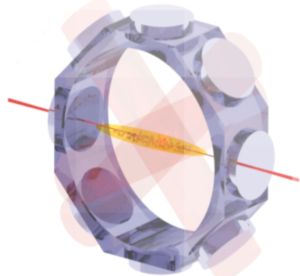One of the most mature applications of quantum technologies concerns the secure exchange of information via quantum communications, which generalize quantum cryptography methods. The basis of this security is the encoding of information in quantum variables, which an eavesdropper cannot access without modifying them. The aim is to build extensive, hybrid quantum communication networks (combining several physical platforms to support quantum information and several types of encoding) and to enable secure exchanges that are resistant to attack by supercomputers, whether classical or quantum.
To achieve this, current research focuses on all the elementary components of a quantum network: sources and detection of photons and entangled states, quantum memories, and atom-light interfaces using hybrid or opto-mechanical systems, useful for developing quantum repeaters to extend the network and improve existing cryptographic technologies.
The most famous example of a quantum advantage is quantum key distribution (QKD). This protocol enables a secret message to be exchanged between two interlocutors, with a level of security that is independent of the computing capabilities (even quantum) of a potential eavesdropper, unlike the cryptographic algorithms used in today’s communication networks. Because of its importance for applications, QKD and quantum cryptography in general have developed very rapidly in recent years, both theoretically (security proofs, device validation criteria) and experimentally (increasingly high-performance systems). The region is therefore a forerunner in quantum technologies, particularly in the transition from research to “out-of-the-lab” applications. In this field, the region is very well endowed, with state-of-the-art teams and excellent theory-experiment and physics-computer synergies.

Figure 3: Quantum information storage is crucial to the development of a quantum communications network. A cloud of cold atoms in the vicinity of a stretched optical fiber enables quantum bits to be efficiently stored.
Objective
Dans le domaine des communications quantiques, QuanTiP soutiendra les recherches et l’innovation avec trois grands objectifs, en utilisant des technologies développées en Île-de-France : développer la cryptographie quantique, améliorer les sources et détecteurs, permettre les communications quantiques à longue distance.
Team Leaders
Nadia BELABAS
C2N, Université Paris-SaclayAlex BREDARIOL-GRILO
LIP6, Sorbonne Université
Board
Alexei Ourjoumtsev
JEIPCFMaria Amanti
MPQRomain Alléaume
TelecomJean-Michel MELKONIAN
ONERATom Darras
WeLinq

